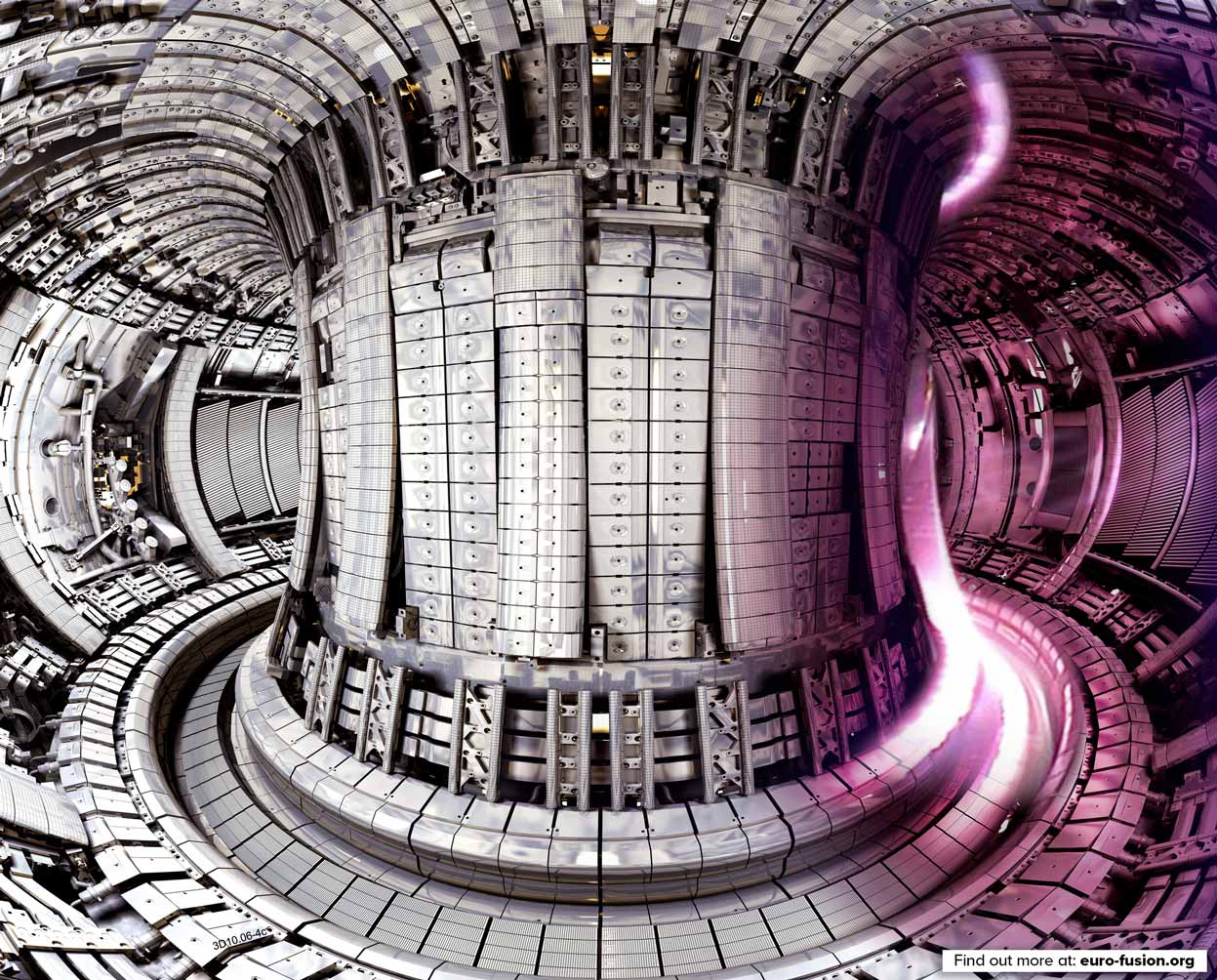
In the quest for clean, sustainable nuclear energy, fusion has been regarded as the power of the future for the human race. Record breaking results have just been announced by the leading fusion experiment, but fusion power is still far from making it to our grids. Upcoming experiments are still being misrepresented in the media and mislead the public about the current capabilities of fusion power– and at this point the claims are clearly false.
The dream of meeting the energy needs of the human race using power plants that can harness the power of the sun has been captivating scientists and citizens for almost a century. Since the discovery of the fusion process in the 1930s, physicists and engineers have never stopped researching this subject. However, it has turned out to be a very complex physics and engineering challenge and progress has been slow. Since the 1960s, every major breakthrough came with an ambitious claim that scientists were only 20 years away from developing a fusion reactor that could connect to the grid. Amazing discoveries are still being made, and recent results are as promising as ever, but scientists still claim we are about 20 years away. These new results shed light on the current state of fusion power and seem to be par for the course of overpromised progress.
For a scientific crash course in the physics of solar fusion and how we have made it happen in the lab here on Earth, head to Appendix I at the end of the article.
Some recent experimental results that will set the stage for the next generation of fusion experiments have come from one of the oldest, most impactful fusion experiments, the Joint European Torus (JET) in Oxfordshire, UK. Since 1984, the JET reactor has been a testing ground for a variety of fusion experiments, and since 2009, has been used as the prototype for the first ever full-scale fusion reactor, the International Thermonuclear Experimental Reactor (ITER), set to come online in 2025. ITER, at $22 billion is the second-most expensive science experiment ever, following only the $150 billion International Space Station, and is a joint project from the EU, US, China, India, Korea, Russia and Japan.
The big news this month was the success of JET’s experiments modeling the most-powerful configuration ITER will be capable of. JET was able to produce an output of 59 megajoules of power in just 5 seconds–a new record for fusion reactions! This result matches the predictions of the JET scientists. It also indicates the predictions of the ITER scientists should come out to be true as well. Something more important than how much energy was created is the efficiency of the reaction. The main goal of fusion research is to achieve what is called “net energy production,” where more energy is produced by the reaction compared to how much energy it takes to run the reactor itself. Not only does the new result not meet this goal, it is actually twice as inefficient as its previous record from 1997. These scientists have made JET into a reactor that produces the most reaction energy, not one that produces the most net energy. Yet ITER scientists still claim that the way the scaling works means that ITER should be able to produce more energy than it takes in. This is where the publicity and claims from ITER start to get misleading.
“ITER will be the first fusion reactor to create more energy than it uses,” said project construction leader of ITER, Norbert Holtkamp, in a TED talk.
“ITER will deliver, in the full demonstration [in 2035], 500 megawatts of power output from the 50 megawatt input,” said ITER director-general, Dr. Bernard Bigot, speaking to the US House of Representatives.
“ITER will produce ten times the power output from fusion energy than we put into the machine,” said Head of the Executive Office at the UK Atomic Energy Authority, Nick Walkden, in a TED talk.
In reality, these claims about the expected results of the experiment are deceptive to the public and to policy-makers. These claims are lying by omission. The claims have two major flaws: the energy put into the system as a whole is far greater than 50 megawatts and the output energy from the reaction must be converted, at a loss, into useful electrical energy. The energy put into the reaction inside the reactor is 50 megawatts, but it takes nearly ten times that amount to run the reactor’s equipment at the same time. Additionally, these claims do not take into account the fact that the energy produced by the reaction must be converted into electrical energy to be output from the system, at best at a loss of 50%. The “500 from 50 megawatts” metric is true of part of the complex reaction and is scientifically useful, but the bold claims about the “machine” or “reactor” having such an efficient energy conversion rate are completely false.
“According to the head electrical engineer, Ivone Benfatto, ITER will actually consume about 440 Megawatts of power while it produces fusion power. The total energy that goes into running the reactor is more than [just the 50 Megawatts] that is put into the reaction itself. Even optimistically, ITER will still consume roughly twice the power it generates,” says Sabine Hossenfelder, PhD and research fellow at the Frankfurt Institute for Advanced Studies, in a video on the topic to her 400k YouTube subscribers, “and yet, science writers and journalists constantly get this wrong. They get the most basic fact wrong on a matter that affects tens of billions of dollars of research funding.”
Imagine if someone tried selling you a car, and said the only power needed was the energy it took you to press your foot on the gas pedal, and only later did you find out you needed to fuel your car with gasoline as well! This is what the team at ITER are doing. They are claiming to get a ten times increase in energy when the machine will likely consume twice the energy it actually produces–and this is only when it is running perfectly.
With a high price tag and following decades of broken promises of fusion power, there is a lot of pressure on this international project. Their results will undoubtedly impress scientists, but not the average person, who expects this project to be able to put “ten times” the power back on the grid and power our homes and businesses. Unfortunately, it looks like the cycle is about to repeat itself and we’ll likely see an overpromised project yet again.
Appendix I:
The fusion happening in the core of the Sun is the process of combining 4 hydrogen atoms to make a single atom of helium. The sum-total energy of that new helium atom is actually slightly less than the total energy of the original 4 atoms–don’t worry about why. Everything in physics has to add up nicely–that means the excess energy can’t stick around, and must get released. This released extra energy drives ALL the processes we see in the Sun. We would love to harness this energy ourselves and use it as the source for ALL the processes on Earth, but the conditions here are (luckily) very different from the conditions in the core of the Sun. The fusion there is happening at a temperature of 27 million degrees Fahrenheit and a pressure 260 billion times the pressure we feel on Earth. That pressure is completely unachievable in the lab, but luckily we can achieve an even higher temperature and make fusion happen that way! Scientists have achieved a temperature of as much as 180 million degrees Fahrenheit in their “tokamak” fusion reactors and have successfully used this design to create little stars on Earth since 1968.


It is interesting to know that this fusion can possibly be a great alternative energy resources which can help us move away from the harmful sources we currently use. This fusion having the process to not emit greenhouse gas is a step in the right direction, but I think it is also weird but unsurprising that the real cost is kept a secret. Due to its early stages it would be possible that the cost is been hidden to not get the tax payers pessimistic about the project, but I agree that they should be transparent about their prices.
Humanity is gearing towards clean and sustainable energy. It is good to know that the project has lasted about a century, recording success in 2009, despite facing significant problems, such as transparency regarding its energy cost. ITER’s scientists and leaders may be overhyping unrealistic expectations that the project might not achieve.